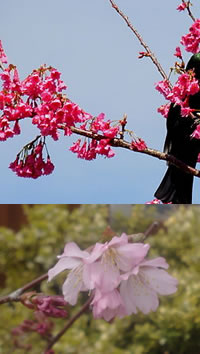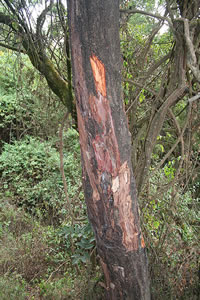February saw the launch of the search for this year's winners of the David Miller Travel Bursary Award. Thanks to continuing support from Vitacress and The Eden Project and the help of a new sponsor, The Eric Gardener Memorial Fund, we are able to offer two awards of £500 each this year. Applications are invited from students in the second or final year of a higher education qualification (BSc, HND, Kew Diploma etc) or studying for an MSc or PhD. Applicants must be students registered for courses in the UK or the Republic of Ireland. Application close on 18 April 2016. Go to our web page for full details.
Thanks to continuing support from and and the help of a new sponsor, , we are able to offer two awards of £500 each this year. Applications are invited from students in the second or final year of a higher education qualification (BSc, HND, Kew Diploma etc) or studying for an MSc or PhD. Applicants must be students registered for courses in the UK or the Republic of Ireland. Application close on 18 April 2016.
February also saw the now regular PHGSW Cannington Conference - see below for report.
In March PHGSW are organising their usual three day meeting in the depths of the south-west. This year's meeting based around Redruth, St Mawes and Mevagissey is on 18 - 20 March.
Peter Grimbly
Contents
The 2016 Cannington Conference - Growing Media
Plant of the Month
News from our Associates
Horticulture Industry News
Events Calendar
Horticulture Group contact details
Related Links
The 2016 Cannington Conference - Growing Media

Mike Pollock, a former Director of the Rosewarne Experimental Horticulture Station and Chief Education Officer for the Royal Horticultural Society opened the proceedings by outlining the history of growing media. He pointed out to start with that there were in fact four interchangeable terms involved depending on who you were talking with – growing media, compost, mixes and substrates. When Mike was training there were still some gardens run on more or less traditional lines and he described the complex compost that was de rigour in the establishment he worked at. It started inevitably with loam, that mysterious substance that soil scientists describe as a roughly equal mix of clay, silt and sand but horticulturists used to create from turfs grown on whatever the local soil contained, usually much enriched with organic matter.
Other ingredients included horse manure, leaves, soot etc and ground bones. Given that he described the head gardener as a descendent of Ghengis Khan one was left wondering if these were the remains of former junior gardeners who hadn’t made the grade!
In 1910 the first John Innes Institute was established at Merton Park in Surrey with the aim of improving all aspects of growing including growing media. In the late 1920s Lawrence and Crane developed through meticulous experimentation the original John Innes composts based on fibrous steam sterilised loam, peat and coarse sharp sand supplemented with fertiliser additives in the form of John Innes Base formulation.
The Californians extended this work with the development of their peat/sand mixes to be followed in the 1970s by the use of pure peat mixes. However, this led on to concern over the habitat destruction caused by peat harvesting and the search for non-peat substrates.

Neil Gray (pictured right) is technical Sales Manager of Melcourt Industries. He set the scene by updating the audience on Melcourt ,a company some of those present had visited in October 2012 – see Newsletter November 2012. The company supplies a range of bark products covering growing media, filtration media, and media for play areas, reptile enclosures etc. The company is owned by Charles Ranson’s sawmill in Bishops Castle and AW Jenkinson another timber company whose 400 plus vehicles are a familiar sight on Britain’s motorways.
He picked up Mike Pollock’s comments on the search for alternatives to peat by explaining how the drive to replace peat underestimated the challenge in finding a replacement. As experimental evidence has mounted there is now a recognised, if complex, ‘decision tree’ that new products have to pass through to ensure their sustainablility and ecological acceptability. Key ingredients that have come through this system are bark, coir and green compost.
Melcourts own work has led to the development of their 'Sylvamix' range of composts. These combine many of the benefits of peat mixes but with clear additional benefits in reduced moss and liverwort invasion and seedling damping off. However, this is not the end of their development. New ingredients are being sent to them on a regular basis and they look at them all. Neil even suggested the prospect of a compost based on old banknotes.

Chris Trimmer (pictured right) is Head Propagator for the National Trust. He described how the original Plant Conservation Centre was based above the walled garden at Knightshayes Court. This site was restrictive but more important surrounded by trees with the ever present threat of disease being transmitted to the rare collections being grown. This resulted in 2010 in their move to a new site in East Devon. The new site, which is in an open location well away from any other plant collections and is not open to the public. Indeed visitors of any type are discouraged. Those that do get to visit are subjected to a hygiene procedure which, while not quite on the scale of an ebola treatment centre, is adequate to protect the plants within.
The centre is for the propagation of the many rare and endangered plants in the Trust’s collections and not for routine propagation of widely available plants. All new material entering the site has to pass through a strict quarantine procedure to ensure that this too does not bring in any disease. This could be plant collected from the Trust's own gardens or from introduction from the wild. The latter must arrive with full accreditation from the country of origin in line with international treaty.
Micropropagation is another key process although they do not have the facilities on site so subcontract this to the Duchy College. Chris had to admit that Melcourt composts did not suit their systems and instead they use a compost supplied by Petersfield Composts. They have also found that Caledonian Tree Company's 'Air Pots' provide the best root growth to ensure that the trees and shrubs that they produce establish well.
Plant of the Month

The genus Prunus consists of 200 or so species although some sources claim around 400 species. The genus is distributed mainly across the Northern temperate zones but there are some tropical species. This month we will look at two temperate zone cultivars and a tropical species.
The genus Prunus is generally defined based on a combination of characteristics which include: a solitary carpel (the structure enclosing the ovules – a combination of the ovary, style and stigma) with a terminal style, a fleshy drupe (fruit), five sepals and five petals and solid branch pith. The drupe contains a single, relatively large, hard coated seed (stone) – familiar to us in cherries, apricots, nectarines, peaches etc.
Ornamental Japanese Cherries are known as the Sato Zakura of Japan. Most are of obscure origin, some having been cultivated in Japan for over 1,000 years. The species most likely to have given rise to these plants are Prunus speciosa and P. jamasakura. According to the Hillier Manual of Trees and Shrubs “Many of the older sorts at least are derived from trees found in the wild. In fact, forms of P. speciosa identical to some of the Sato Zakura have been found growing wild in Japan.”
Collingwood Ingram (1880-1981) came from a journalistic family, but his passion was natural history. Before WW1 his passion was ornithology but after serving as a Compass Officer with the Royal Flying Corps during the war his interests turned to plants, and in particular to Japanese flowering cherries. He developed a magnificent garden in Benenden in Kent. By 1926 he was considered a world authority on the subject and invited to address the Cherry Society of Japan. His book, Ornamental Cherries, published in 1948 became a key reference text on the subject. This book can still be bought today with second hand copies available on Amazon from £50.
Ingram introduced many Japanese Cherries to this country. One of the cultivars he introduced was ‘Kursar’. The parent species are Prunus campanulata (upper picture by Walter Rumsby) and P. nipponica var. kurilensis (lower picture by Andy Mabbett). It is described in the Hiller manual of trees and shrubs “The flowers, though small, are rich deep pink and borne in great profusion with, or just before, the reddish-bronze young leaves, in March or early April.” The Royal Horticultural Society gave it an Award of Garden Merit in 2002.
Selected in 1979 from a seedling of Kursar descent that was raised at Kalmhout, the cultivar ‘Collingwood Ingram’ is suitable recognition indeed of the eminence of this man in the field of flowering cherries. It is distinguished from Kursar by its deeper coloured flowers.
To find out more about Prunus, why not join a Plant of the Month guided tour at the Royal Botanic Gardens, Kew on Tuesdays in April.
Alison Foster
Royal Botanic Gardens Kew
Medicinal Plant of the Month

Prunus africana was first described by William Hooker and his son Joseph Dalton Hooker from material sent to them at Kew by Gustav Mann when on expedition in Cameroon. The Hookers named the plant Pygeum africanum although this was changed in 1965 to Prunus africana. This species is native to tropical and sub-tropical montane forest across Africa (including Angola, Burundi, Cameroon, The Democratic Republic of the Congo, Equatorial Guinea, Ethiopia, Kenya, Lesotho, Madagascar, Mozambique, Rwanda, Sao Tomé and Principe, South Africa (Eastern Cape Province, Gauteng, KwaZulu-Natal, Limpopo Province, Mpumalanga), South Sudan, Sudan, Swaziland, Tanzania, Uganda, Zambia and Zimbabwe) and can reach heights of more than 30m.
It is an important economic species being used locally as fuel wood and for charcoal, for tool handles, as a forage plant in honey production, in protecting water catchments, as a boundary marker, and especially medicinally. Its multifarious medicinal uses include to treat genito-urinary complaints, allergies, inflammation, kidney disease, malaria, stomach ache, fever, chest pain, heart burn, madness and for animal medicines.
However it is the export market for which the bark (picture right by Marco Schmidt) is harvested for its medicinal properties, in particular for its use to treat benign prostate hyperplasia, which threatens to wipe out this species. The Convention on International Trade in Endangered Species of Fauna and Flora (CITES) placed this species on its Appendix II list in 1995, meaning that it is not immediately threatened with extinction but may be so if its trade is not closely regulated. Producers have to declare exports, to set a 'scientific non-detriment finding' for any annual quotas and these have to be reported to CITES.
Worldwide exports of dried bark in 2000 have been estimated at 1350-1525 metric tons per year, down from its peak of 3225 tons in 1997. Recommended harvesting practices encourage stripping of two quarter panels from a tree of more than 30 cm diameter at breast height, (approximate age of 12 to 15 years) which will then regenerate and may be exploited at between 5 to 15 year intervals without killing the tree. About 2000 kg of fresh bark are equal to 1000 kg of dried bark, which is needed to make 5 kg of extract. An average mature tree yields 75 kg of bark although total removal of bark would of course cause the tree to die.
In 2000, Plantecam, the largest bark exporter in Africa, closed its extraction factory in Cameroon, due to complex ecological, social, and economic factors. Wild-collection is no longer sustainable (and probably never was) where harvest seriously affects morbidity and mortality rates of harvested populations.
A report was published from a meeting of a CITES Prunus africana working group in September 2008 to discuss a review of significant trade recommendations for the species. By this meeting many of the countries involved in the harvesting of the bark had imposed a voluntary zero export limit (although some had not) whilst a way to ensure sustainable levels of harvest was worked out.
The activity of the extracts is possibly due to beta-sitosterol which is also present in other plants that are traditionally used for the same purpose. Clinical trials support its efficacy.
It is hoped that this species is at the beginning of a transition from an exclusively wild-collected species to that of a cultivated medicinal tree.
Alison Foster
Royal Botanic Gardens Kew
News from our Associates
Commercial Horticultural Association
This October (26 - 27) CHA are launching GrowQuip, a major new international conference and exhibition for the commercial horticultural industry. To be held at the Stratford Manor Hotel, Stratford on Avon, GrowQuip will feature a one day conference followed by a trade exhibiton. On 27th October the trade exhibition will be open to all growers free of charge. For details of the conference, exhibitor packages and sponsorship opportunities visit the CHA website.
UK Plant Science Federation
The Federation's annual conference will take place at the John Innes Centre, Norwich on 11 -12 April 2016. Entitled 'Plants in a changing world: molecule to ecosystem'. The meeting will host a diverse range of talks, all held in plenary sessions and pitched towards a general plant science audience.
Horticulture Industry News
Urine fed algae give tastier tomatoes
Researchers investigating the recovery of potential fertilisers from domestic waste have managed to transform human urine to a stable and safe food solution that appeared to be excellent for the cultivation of a genus of tiny algae, rich in valuable proteins, called Spirulina. The algae were then used as biological fertiliser in the cultivation of tomatoes, with remarkable results.
The tomatoes contained 30 per cent more sugars and 70 per cent more natural colour pigments than traditionally grown tomatoes. This way of recovering fertilizers opens up new possibilities for the cultivation of food on the moon or during a mission to Mars. The researchers are now further developing the project with several industry partners.
NIAB & EMR join forces
East Malling Research (EMR) has become part of the NIAB group. This alliance, bringing together internationally renowned expertise in crop genetics, agronomy, environmental and data science, will strengthen NIAB’s ambition to lead the UK in crop innovation. EMR brings international leadership in top fruit and soft fruit research, complementing NIAB’s scientific expertise in arable crops, potatoes and ornamentals. Both organisations have a focus on industry-facing, applied research aimed at addressing the challenges facing UK and global agriculture. The partnership will strengthen the UK’s crop science infrastructure and capabilities, with the pooling of complementary research expertise, and a shared commitment to the translation and application of science to support crop production in the UK and internationally.
The fall and rise of floral resources in Britain
By combining vegetation surveys and direct nectar measurements scientists have found evidence for substantial losses in nectar resources in England and Wales between the 1930s and 1970s; however, total nectar provision in Great Britain as a whole had stabilized by 1978, and increased from 1998 to 2007. These findings concur with trends in pollinator diversity, which declined in the mid-twentieth century but stabilised more recently. The diversity of nectar sources declined from 1978 to 1990 and thereafter in some habitats, with four plant species accounting for over 50% of national nectar provision in 2007. Calcareous grassland, broadleaved woodland and neutral grassland are the habitats that produce the greatest amount of nectar per unit area from the most diverse sources, whereas arable land is the poorest with respect to amount of nectar per unit area and diversity of nectar sources. Although agri-environment schemes add resources to arable landscapes, their national contribution is low. Owing to their large area, improved grasslands could add substantially to national nectar provision if they were managed to increase floral resource provision. This national-scale assessment of floral resource provision affords new insights into the links between plant and pollinator declines, and offers considerable opportunities for conservation. More
Breakthrough against blight ...
Scientists have managed to track down the origins of Phytophthora infestans, the pathogen responsible for blight of potato, tomato and other related hosts, as well as to spatially map its distribution and diversity across Europe. An international research group has pinned down the origins of potato late blight to a scenic highland valley in central Mexico. The findings are relevant not just in terms of agricultural history, but also because they may aid researchers in their quest for food security through disease resistance. After sequencing genes in representative samples from Mexico and the South American Andes, researchers found P. infestans was likely to have originated in Mexico. Using latest generation approaches the team determined that P. infestans co-evolved in the Toluca Valley hundreds of years ago with plants that were distant cousins of modern potatoes, which produced tubers but were more often thought of as a weed than a vegetable crop. More
... potato blight mapped
Another group has been able to spatially plot the distribution and diversity of the plant pathogen across Europe, using genetic analysis techniques similar to those employed in forensic science. Plant scientists from the EuroBlight consortium, working with industry and research partners, have presented their first report on its pathogen monitoring in potato crops. This is available on the research group website, and collates information from 795 samples collected in 2013 from 25 European countries. More
Kakadu plum improves shelf-life and nutrition
An Australian catering business has started adding a Kakadu plum, Terminalia ferdinandiana, extract to its pre-prepared meals, to improve their shelf-life and nutritional value. The company makes a range of pre-prepared meals, with the vast majority sold into Indigenous communities across the Northern Territory. The company is involved in a research project with the University of Queensland into ways of using the Kakadu plum as a preservative. They hope to show that it will increase the shelf-life, giving more time to get products out to Indigenous communities with better nutritional value than they might have had, if they were stored in a freezer for a very long time. More
Events Calendar
Other Events of Interest:
Plant Resistance to Insects Symposium
5 - 8 Mar 2016
Stellenbosch, South Africa
Processing Tomato Congress
6 - 9 Mar 2016, International Society for Horticultural Science
Santiago, Chile
Tropical and Subtropical Ornamentals
7 - 9 Mar 2015, International Society for Horticultural Science
Krabi Province, Thailand
Plant Breeding Symposium: 'Back to the Phenotype'
8 - 10 Mar 2016, South African Plant Breeding Association
Stellenbosch, South Africa
In Vitro Culture and Horticultural Breeding
13 - 15 Mar 2015, International Society for Horticultural Science
Giza, Egypt
Sexual Plant Reproduction
18 - 23 Mar 2016
Tucson, USA
Induced Plant Development
4 - 6Apr 2016, Sainsbury Laboratory
Cambridge, UK
Molecular Encoding of Specificity in Plant Processes
4 - 6 Apr 2016, University of Tubingen
Tubingen, Germany
Root Phenotyping
7 - 8 Apr 2016, UK Plant Phenomic Network
Nottingham, UKBiotechnology of Fruit Species
Vaccinium
10 - 14 Apr 2015,
Orlando, USA
The Root Zone: Soil Physics and Beyond
10 - 14 Apr 2015, Soil Science Society of America
Sede Boqer, Israel
Organic Greenhouse Horticulture
11 - 14 Apr 2015, European Cooperation in Science & Technology
Izmir, Turkey
Plants in a changing world: molecule to ecosystem
11 - 12 Apr 2015, UK Plant Science Federation
Norwich, UK
Pulses for Health, Nutrition and Sustainable Agriculture in Drylands
13 - 15 Apr 2015, ICARDA
Rabat, Morocco
Biotechnology of Fruit Species
27 Apr 2015 - 1 May 2015, International Society for Horticultural Science
Antalya, Turkey
Plant developmental evolution
15 - 19 May 2015, New Phytologist Trust
Beijing, China
Role of Plant Genetic Resources on Reclaiming Lands and Environment Deteriorated by Human and Natural Actions
16 - 20 May 2015, Plant Genetic Resources Commission of International Society for Horticultural Science
Shiraz, Iran
Post Graduate Horticulture Scientists
12 - 13 May 2015, International Society for Horticultural Science
Palermo, Italy
Light in Horticulture
22 - 26 May 2015, International Society for Horticultural Science
East Lancing, USA
Floral Biology and S-Incompatibility in Fruit Species
23 - 26 May 2015, ISHS Commission of Molecular Biology
Murcia, Spain
International Cool climate Wine Symposium
26 - 28 May 2016
B righton, UK
Iron Nutrition and Interactions in Plants
30 May 2015 - 3 Jun 2015,
Madrid, Spain
Lychee, Longan and Other Sapindaceae Fruits
31 May 2015 - 3 Jun 2015,
Sabour, India
Horticulture Group Contact Details
For submitting ideas or to volunteer to be part of a committee or a group, please contact:
Chairman - Tony Girard
Meetings Coordinator - Peter Grimbly
Minutes Secretary - Margaret Waddy
Newsletter co-ordinator - Sue Grimbly scihortigroup@btinternet.com
